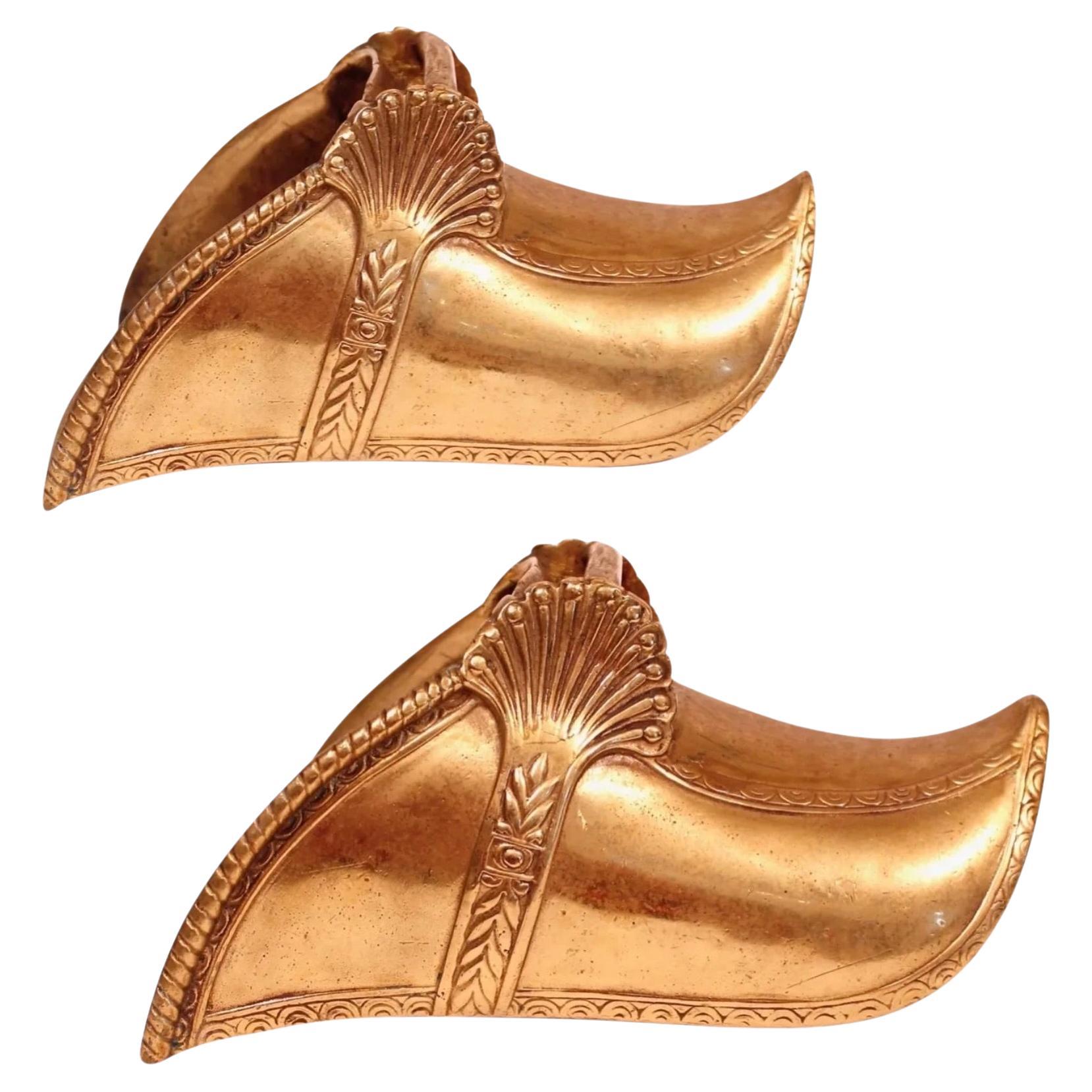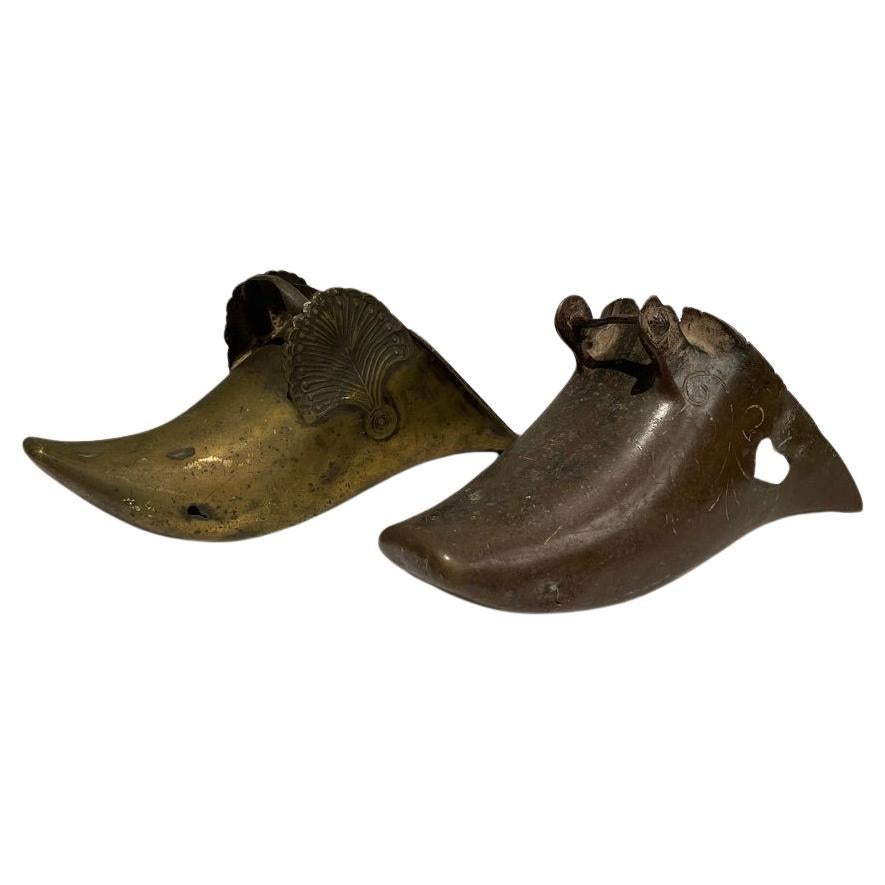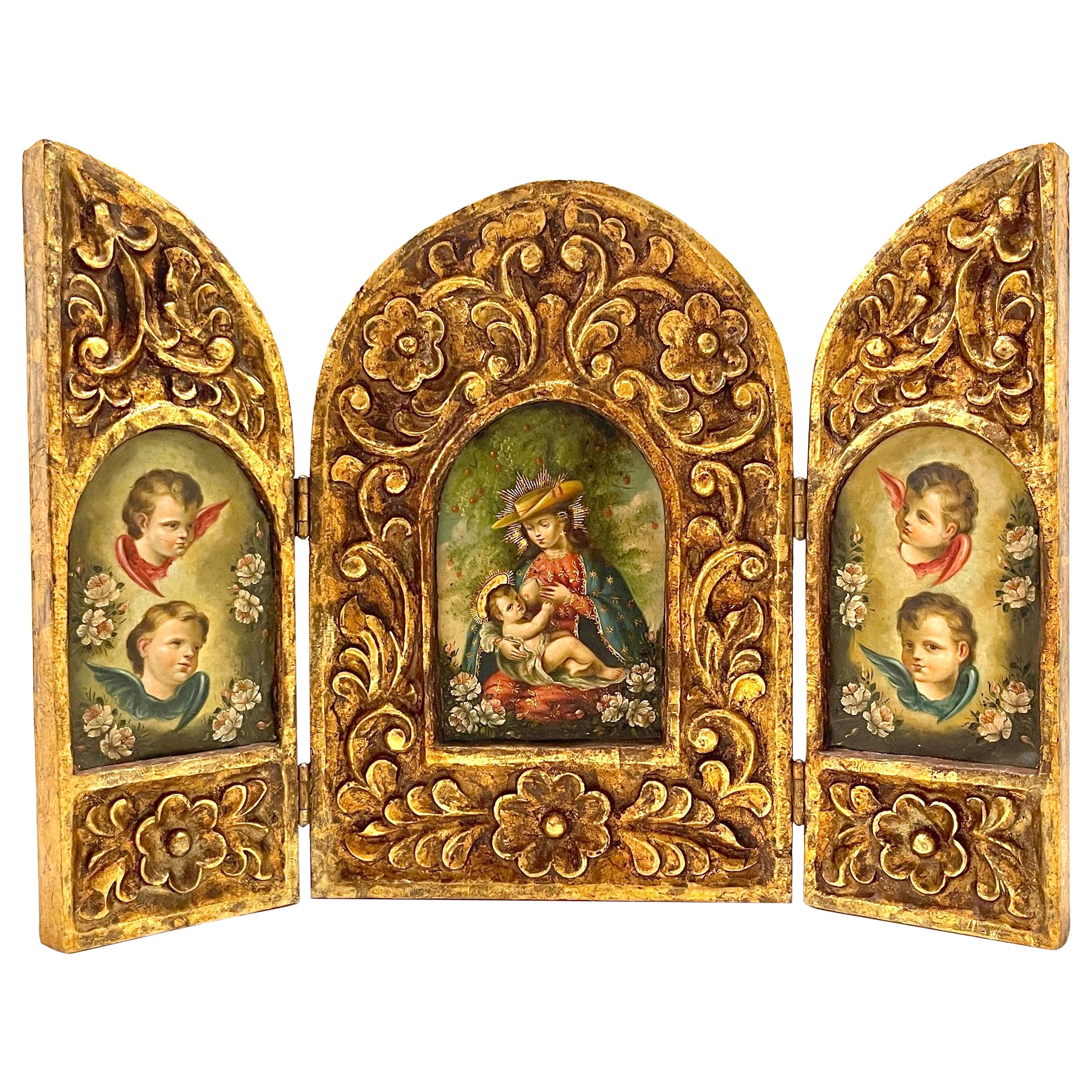Items Similar to 19th Century Spanish Colonial Our Lady of Guadalupe Retablo
Want more images or videos?
Request additional images or videos from the seller
1 of 11
19th Century Spanish Colonial Our Lady of Guadalupe Retablo
About the Item
A stunning and rare Spanish Colonial Our Lady of Guadalupe retablo painting with beautiful patina, displayed in an altarpiece shrine. Handcrafted around present day New Mexico during the early to mid 19th century, the unframed antique religious devotional retablo oil painting on tin has remarkable detail and strong vibrant colors. Depicting Catholic Patron Saint Our Lady of Guadalupe, a praying Blessed Virgin Mary with hands held together in prayer pose, tilted head, full gently curving body, surrounded by a mandorla comprised of golden rays. Encased in a pine wood shrine with ornate sculptural embossed metal trim along the upper edge and sides, styled like reaching hands, and decorated with four silver tone relief accents, featuring Christ, the heart and the cross. The reverse side has a later added self-leveling hanger for wall hanging or mounting over a doorway as an overdoor. Circa 1820 to 1850.
Orgin:
The area this was made went through many changes during that time period, from a series of religious outposts called Spanish Missions in the Province of Santa Fe de Nuevo México, established by Franciscan friars under charter from the Spanish Empire and the government of the Viceroyalty of New Spain, to Mexican Independence, to a territory of the United States.
Condition:
Given the age of this painting, it's in outstanding condition. Having a nicely aged patina, minor distressing and loss, slight bending at corners, all consistent with age.
Dimensions (approx):
Shrine: 11.5"H, 11"W, 3"D. 1lb total
Retablo: 6.25"H, 4.5"W
About / History:
Long a popular folk art form in colonial Spanish and Mexican culture, retablos are devotional paintings depicting divine icons and symbols, particularly Catholic patron saints. Chosen as representations and guardians of particular occupations and life situations, patron saints are often turned to in times of need or to express gratitude for a blessing. Displayed on a church altar, in homes, or carried during travel to honor the saint or given as gifts of fortune and inspiration, retablos reflect a beloved historical tradition and cultural artistry.
Mexican retablos of the 19th century are small oil paintings, usually done on tin, by folk artists with minimal artistic training. The Spanish word retablo is derived from the Latin retro-tabulum, meaning "behind the table," that is, behind the altar. In the European middle ages, the term was used to refer to the large screens that were placed behind altars in churches.These wooden altar screens were decorated with paintings, wood carving, and sculptures, becoming increasingly ornate over time. Many churches in colonial Mexico had such altar screens. Eventually, the term retablo came to be used in reference to individual paintings on wood, canvas, or other materials.
In early colonial Mexico, wealthy Spanish or criollo (a person born to Spanish parents in the New World) patrons commissioned religious paintings on canvas. In the 18th century, copper was also used as a surface medium. At that time, the middle classes made do with cruder paintings on wood.
Late in the 18th century, British metallurgists developed a technique to bond tin to iron sheets. This provided a new surface medium for Mexican folk painters, who began to use tin-plated sheets for their religious paintings of saints, or retablos, in the 1820s. By around 1830 tin had replaced copper and canvas as the preferred surface for retablo paintings, and these paintings were now purchased by middle and lower-class mestizo families rather than the wealthy classes.
The folk artists who produced retablos in the 19th century painted in a baroque manner, long since superseded by neoclassical and romantic styles in the world of academic painting. They sought to use dramatic poses, chiaroscuro, and realistic portrayals to convey their religious feelings. However, these attempts were naïve, conventionalized, and very often unsuccessful. But of course, the artists and their patrons were not interested in the fashions of academic art. They sought to produce an image to stimulate devotion that was readily identifiable and lovingly decorated. Despite their lack of training, these artists could produce ingenious and spontaneous pictures that conveyed a strong feeling of devotion.
The retablos were painted in a limited range of colors, using reds, blues, and dark yellows, plus flesh tones and an occasional dark green, all of which were utilized by the artist of this painting.
Our Lady of Guadalupe History:
In 1531, the Virgin Mary appeared to Mexican native Juan Diego, offering her help if Juan would ask the bishop to build a chapel in her honor on the hill where she now appeared. Juan did as he was asked, but the bishop demanded a sign from the Virgin. The following morning, she appeared and healed Juan's dying uncle and provided Juan with roses in winter. He wrapped them in his tilma and ran to the Bishop. Opening his cloak to the bishop, the roses fell, replaced with the image of the Virgin Mary. The Basilica of Our Lady of Guadalupe was built and 10 million natives were converted in the next 10 years. The Aztec practice of human sacrifice was forever ended and an era of peace began. Our Lady of Guadalupe is recognized as the patron saint of Mexico and the Americas.
- Dimensions:Height: 11.5 in (29.21 cm)Width: 11 in (27.94 cm)Depth: 3 in (7.62 cm)
- Style:Spanish Colonial (In the Style Of)
- Materials and Techniques:
- Place of Origin:
- Period:
- Date of Manufacture:circa 1820-1850
- Condition:Wear consistent with age and use. Minor losses. Minor structural damages. Minor fading. Given the age of this painting, it's in outstanding condition. Having a nicely aged patina, minor distressing and loss, slight bending at corners, all consistent with age.
- Seller Location:Forney, TX
- Reference Number:1stDibs: LU5977226979472
About the Seller
4.8
Platinum Seller
These expertly vetted sellers are 1stDibs' most experienced sellers and are rated highest by our customers.
Established in 2013
1stDibs seller since 2021
200 sales on 1stDibs
Typical response time: <1 hour
- ShippingRetrieving quote...Ships From: Forney, TX
- Return PolicyA return for this item may be initiated within 7 days of delivery.
More From This SellerView All
- 18th/19th Century Spanish Colonial Carved Painted Wooden Santo Altar FigureLocated in Forney, TXA lovely antique Spanish Colonial hand carved and painted wood santo altar figure - religious folk art sculpture. 18th/19th century, possibly earlier, most likely depicting Saint F...Category
Antique 18th Century Spanish Colonial Religious Items
MaterialsWood
- 19th Century Spanish Colonial Religious Folk Art Santo Altar FigureLocated in Forney, TXAn antique Spanish Colonial period hand carved and painted santo church altar figure. Born in Mexico in the first half of the 19th century, the religious...Category
Antique 19th Century Mexican Folk Art Religious Items
MaterialsWood, Paint
- 17th Century Spanish Colonial Hispano-Philippine Carved SantoLocated in Forney, TXA scarce 17th century Spanish Colonial carved wood santo with provenance from the National Museum of the Philippines Manila. circa late 1600s A large part of what makes this example so very rare is not just the age and condition, but the saint depicted, San Roque. The Hispano-Philippine (Spanish-Filipinos) hand carved hard wood religious altar figure presents splendidly, with scattered remnants of original gesso and polychrome pigments, the exceptionally sculpted religious folk art depicting San Roque (Saint Roch or Rocco), the 14th century Catholic patron saint frequently invoked against the plaque, various infectious disease, as well as patron saint of dogs, invalids, of falsely accused people, and of bachelors, amongst others. Provenance / Acquisition: Retaining registration - identification label to verso from The Republic of the Philippines (RP) National Museum of the Philippines Manila with hand written registration number. Acquired from highly reputable auction house, Austin Auction Gallery, est. 1982, Austin, Texas. February 2022 catalog. Dimensions: (approx) Overall: 15.75" High, 5" Wide, 4" Deep. Figure: 14" High 1.5lbs Great original antique condition, especially considering it's around 350 years old. Nicely aged patina over the whole. Presented on a later wood plinth base. Typical loss to right arm, minor finish losses, old tiny metal plate added to prevent age related splitting, all wear consistent with age, and only adds to the overall sophisticated character, authenticity, and charming rustic warmth that can only be acquired over long periods of time. We here at Lynx Hollow Antiques absolutely love religious antiques, from an antique altar, church architectural salvaged building and ornamental elements, reliquary, tabernacle cabinet...Category
Antique 17th Century Spanish Colonial Religious Items
MaterialsGesso, Hardwood
- Antique Spanish Colonial Silver Santo CrownLocated in Forney, TXA scarce 19th century Spanish Colonial style silver saint's crown, to be mounted on the head of a church altar figure, having a cross finial, pierced arches with foliate motif and fi...Category
Antique 19th Century Spanish Colonial Religious Items
MaterialsSilver
- Antique Spanish Colonial Santo Religious Altar FigureLocated in Forney, TXAn exceptional example of Spanish Colonial style, born in Mexico in the 19th century, this large hand carved and painted santo religious folk art altar f...Category
Antique 19th Century Mexican Spanish Colonial Religious Items
MaterialsGlass, Art Glass, Wood, Paint
- 18th Century Spanish Colonial Church Altar Table now Sideboard ServerLocated in Forney, TXA magnificent rustic Spanish Colonial antique, circa 1725, church altar with remarkable patina and detailing. Hand-crafted in the first half of the 18th century, most likely commissioned by the Spanish Empire for use in a Colonial religious Mission, now fashioned with later antique elements and repurposed for use as a sideboard. The scarce Baroque period ecclesiastical architectural church altar presents with a raised gallery shelf back topped with a single board, over a massive, thick pine plank wooden slab top, featuring impressive rich patina, rustic charm and antique character. Mounted over the distinctive architectural trapezoid shaped molded base with rich hand carved and polychrome painted decoration, including the sophisticated original Italian / European inspired trompe-l'œil marbleizing finish, which was a variety of faux painting techniques used only by highly skilled artisans to create the distinctive and varied patterns of marble, in an effort to reproduce the colors, veining and luster of real marble or other building materials. Rising on solid supports enhanced with recessed paneling, smooth rounded corners and edge work and stepped molded trim. Beautiful, nicely aged patina over the whole, highly desirable heavily worn, naturally distressed, chippy paint craquelure finish that has been stabilized to minimize further loss, that does not detect from the aesthetics or functionality, but only adds to the overall elegant warmth and rich historical depth, that can only be acquired over three centuries. Very strong, sturdy, stable. Delivered cleaned, hand waxed, luminous polished French patina finish, ready for immediate use, and many more years of generational enjoyment. Dimensions: (approx) 37.25" High, 62" Wide, 27" Deep The large size, and substantial proportions, make this excellent for a variety of different uses, including as a distinctive buffet table or server, credenza, oversized console, farmhouse kitchen...Category
Antique 18th Century Central American Baroque Religious Items
MaterialsWood, Pine, Paint
You May Also Like
- Pair Of Brass Stirrups, 19th Century, Spanish ColonialLocated in Free Union, VAAn elegant pair of heavy cast brass stirrups with Neoclassical relief decoration, the highlight being the bold anthemion motifs clasping the bar that catches the stirrup leathers. Th...Category
Antique 19th Century Brazilian Spanish Colonial Arms, Armor and Weapons
MaterialsBrass
- Two 19th Century Spanish Colonial Brass Slipper StirrupsLocated in Stamford, CTTwo great examples of 18th century Spanish Colonial slipper stirrups. Not a pair, each similar yet different. One is brass with a lovely floral decoration, the other a rare copper type with a simple incised design. Both with a wonderful patina that only comes with real age and use. These definitely put in some serious miles. Possibly used in battle, or just to protect the rider from bramble. Imagine what these pieces of history may have witnessed. Unique gift for the equestrian or collector of horse memorabilia...Category
Antique Mid-18th Century Peruvian Spanish Colonial Arms, Armor and Weapons
MaterialsBrass, Copper
- Late 19th Century Spanish Colonial Carved Santos with Glass EyesLocated in Santa Monica, CALate 19th century hand-carved Santos with inset glass eyes and original gesso paint surface. On custom museum display stand. Base measures 6" x 6".Category
Antique Late 19th Century Central American Spanish Colonial Sculptures a...
MaterialsGesso, Wood
- 19th C. Spanish Colonial Carved Giltwood Triptych of Virgin Mary & Christ ChildLocated in West Palm Beach, FL19th century Spanish Colonial carved giltwood Triptych of Virgin Mary & Christ Child Late 19th century, South America Of exceptional quality, the hinged three panel devotional ic...Category
Antique Late 19th Century South American Spanish Colonial Religious Items
MaterialsCanvas, Giltwood
- Late 19th Century Carved Spanish Colonial Christ Nino Santo with Glass EyesLocated in Santa Monica, CALate 19th century carved baby Jesus Santos with glass eyes and custom display stand. Handmade with carved wood and gesso. Glass inset eyes. Left and r...Category
Antique 19th Century South American Spanish Colonial Religious Items
MaterialsGesso, Wood
- Russian Icon 'Our Lady of Kazan' with Selected Saints, Mid-19th CenturyLocated in NICE, FRWe present you with a beautiful orthodox icon from the mid-19th century in Russia. Our Lady of Kazan, also known as the Mother of God of Kazan, known as the Holy Protector of Russia,...Category
Antique Mid-19th Century Russian Religious Items
MaterialsWood
Recently Viewed
View AllMore Ways To Browse
Our Lady Or Guadalupe
New Items
Add Item
Green Items
Gift Items
Colonial Spanish
Mid Century Colonial
Colonial Midcentury
Small Silver Item
19th Century Icon
New Colonial
Antique Spanish Colonial Furniture
Spanish Colonial Antique Furniture
Mid Century Colonial Style Furniture
Antique American Colonial Furniture
19th Century Spanish Painted
Antique Religious Paintings
Antique Religious Painting





